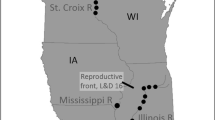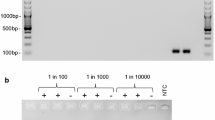Abstract
To compensate for the limited number of morphological characteristics of fish eggs and larvae, we established a convenient and robust method of species identification for eggs of the Japanese eel (Anguilla japonica) using a real-time polymerase chain reaction (PCR) that can be performed onboard research ships at sea. A total of about 1.2 kbp of the mitochondrial 16S ribosomal RNA gene sequences from all species of Anguilla and 3 other anguilliform species were compared to design specific primer pairs and a probe for A. japonica. This real-time PCR amplification was conducted for a total of 44 specimens including A. japonica, A. marmorata, A. bicolor pacifica, and 6 other anguilliform species. Immediate PCR amplification was only observed in A. japonica. We then tested this method under onboard conditions and obtained the same result as had been produced in the laboratory. These results suggest that real-time PCR can be a powerful tool for detecting Japanese eel eggs and newly hatched larvae immediately after onboard sampling during research cruises and will allow targeted sampling efforts to occur rapidly in response to any positive onboard identification of the eggs and larvae of this species.





Similar content being viewed by others
References
J. Aoyama K. Tsukamoto (1997) ArticleTitleEvolution of the freshwater eels Naturwissenschaften 84 17–21 Occurrence Handle1:CAS:528:DyaK2sXhtVWhtbw%3D Occurrence Handle9050003
J. Aoyama N. Mochioka T. Otake S. Ishikawa Y. Kawakami P.H.J. Castle M. Nishida K. Tsukamoto (1999) ArticleTitleDistribution and dispersal of anguillid leptocephali in the western Pacific revealed by molecular analysis Mar Ecol Prog Ser 188 193–200
J. Aoyama S. Watanabe M. Nishida K. Tsukamoto (2000) ArticleTitleDiscrimination of catadromous eel species, genus Anguilla, using PCR-RFLP analysis of the mitochondrial 16SrRNA domain Trans Am Fish Soc 129 873–878 Occurrence Handle1:CAS:528:DC%2BD3cXktFGiur8%3D
J. Aoyama S. Ishikawa T. Otake N. Mochioka Y. Suzuki S. Watanabe A. Shinoda J. Inoue P.M. Lokman T. Inagaki M. Oya H. Hasumoto K. Kubokawa T.W. Lee H. Fricke K. Tsukamoto (2001) ArticleTitleMolecular approach to species identification of eggs with respect to determination of the spawning site of the Japanese eel Anguilla japonica Fish Sci 67 761–763 Occurrence Handle1:CAS:528:DC%2BD3MXmsFynur4%3D
J. Aoyama S. Wouthuyzen M.J. Miller T. Inagaki K. Tsukamoto (2003) ArticleTitleShort-distance spawning migration of tropical freshwater eels Biol Bull 204 104–108 Occurrence Handle12588749
M.A. Coffroth J.M. Mulawka SuffixIII (1995) ArticleTitleIdentification of marine invertebrate larvae by means of PCR-RAPD species-specific markers Limnol Oceanogr 40 181–189 Occurrence Handle1:CAS:528:DyaK2MXmtFaitbc%3D Occurrence Handle10.4319/lo.1995.40.1.0181
E.D. Garland C.A. Zimmer (2002) ArticleTitleTechniques for the identification of bivalve larvae Mar Ecol Prog Ser 225 299–310
M.P. Hare S.R. Palumbi C.A. Butman (2000) ArticleTitleSingle-step species identification of bivalve larvae using multiplex polymerase chain reaction Mar Biol 137 953–961 Occurrence Handle1:CAS:528:DC%2BD3MXkvFWlsw%3D%3D
D.E. Medeiros-Bergen R.R. Olson J.A. Conroy T.D. Kocher (1995) ArticleTitleDistribution of holothurian larvae determined with species-specific genetic probes Limnol Oceanogr 40 1225–1235
A. Meyer (1993) Evolution of mitochondrial DNA in fishes P.W. Hochachka T.P. Mommsen (Eds) Biochemistry and Molecular Biology of Fishes Elsevier Amsterdam, Netherlands 1–38
M. Miya M. Nishida (1996) ArticleTitleMolecular phylogenetic perspective on the evolution of the deep-sea fish genus Cyclothone (Stomiiformes: Gonostomatidae) Ichthyol Res 43 375–398
O. Tabeta N. Mochioka (1988) Leptocephali M. Okiyama (Eds) An Atlas of the Early Stage of Fishes in Japan Tokai Univ. Press Tokyo, Japan 15–64
H. Tanaka H. Kagawa H. Ohta (2001) ArticleTitleProduction of leplocephali of Japanese eel (Anguilla japonica) in captivity Aquaculture 201 51–60
K. Tsukamoto (1992) ArticleTitleDiscovery of spawning area for Japanese eel Nature 356 789–791
K. Tsukamoto T. Otake N. Mochioka T.W. Lee H. Fricke T. Inagaki J. Aoyama S. Ishikawa S. Kimura M.J. Miller H. Hasumoto M. Oya Y. Suzuki (2003) ArticleTitleSeamounts, New Moon and Eel Spawning: the search for the spawning site of the Japanese eel Env Biol Fish 66 221–229
K. Yamamoto K. Yamauchi S. Kasuga (1975) ArticleTitleOn the development of the Japanese eel, Anguilla japonica Bull Jpn Soc Sci Fish 41 21–28
H. Zhang N. Mikawa Y. Yamada N. Horie A. Okamura T. Uto S. Tanaka T. Motonobu (1999) ArticleTitleForeign eel species in the natural waters of Japan detected by polymerase chain reaction of mitochondrial cytochrome b region Fish Sci 65 684–686 Occurrence Handle1:CAS:528:DyaK1MXmvFWktLk%3D
Acknowledgements
We sincerely thank the following colleagues for assistance in sampling: S. Sasai, J. G. Inoue, A. Shinoda, and Y. Kimura. We are grateful to captain S. Suzuki and the crew of the RV Tansei-Maru, Ocean Research Institute, University of Tokyo, for their help in the onboard testing of the new method. Thanks are due to M. Otsuka, T. Saito, K. Takeishi, and H. Shiraga of Applied Biosystems Japan for their technical support and for providing us reagents and equipment for our molecular experiments. The paper greatly benefited from critical comments and suggestions on an early draft by M. J. Miller. We thank M. Oya for her assistance in many aspects of the project.
S.W. was partly supported by the Ito Foundation for Promotion of Ichthyology and the Sasakawa Scientific Research Grant from the Japan Science Society. S.W. and T. Y. were supported by Research Fellowship of the Japan Society for the Promotion of Science for Young Scientists. This study was supported partly by Grants-in-Aid (08456094, 10460081, 08041139, 11691177, and 12NP0201) from the Ministry of Education, Culture, Sports, Science and Technology of Japan; “Research for the Future” Program JSPS-RFTF 97L00901 from the Japan Society for the Promotion of Science; Touwa Shokuhin Shinkoukai; and the Eel Research Foundation of Nobori-kai.
Author information
Authors and Affiliations
Corresponding author
Rights and permissions
About this article
Cite this article
Watanabe, S., Minegishi, Y., Yoshinaga, T. et al. A Quick Method for Species Identification of Japanese Eel (Anguilla japonica) Using Real-Time PCR: An Onboard Application for Use During Sampling Surveys. Mar Biotechnol 6, 566–574 (2004). https://doi.org/10.1007/s10126-004-1000-5
Received:
Accepted:
Published:
Issue Date:
DOI: https://doi.org/10.1007/s10126-004-1000-5




